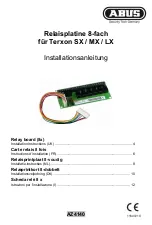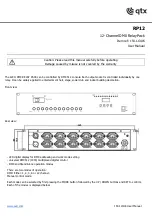
D.2
SEL-700G Relay
Instruction Manual
Date Code 20170814
DNP3 Communications
Introduction to DNP3
Each level is a proper superset of the previous lower-numbered level. A
higher-level device can act as a master to a lower-level device, but can only
use the data types and functions implemented in the lower level device. For
example, a typical SCADA master is a Level 3 device and can use Level 2 (or
lower) functions to poll a Level 2 (or lower) device for Level 2 (or lower) data.
Similarly, a lower-level device can poll a higher-level device, but the lower
level device can only access the features and data available to its level.
In addition to the eight-volume DNP3 specification, the protocol is further
refined by conformance requirements, optional features, and a series of
technical bulletins. The technical bulletins supplement the specifications with
discussion and examples of specific features of DNP3.
Data Handling
Objects
DNP3 uses a system of data references called objects, defined by the Basic 4
standard object library. Each subset level specification requires a minimum
implementation of object types and recommends several optional object types.
DNP3 object types, commonly referred to as objects, are specifications for the
type of data the object carries. An object can include a single value or more
complex data. Some objects serve as shorthand references for special
operations, including collections of data, time synchronization, or even all
data within the DNP3 device.
If there can be more than one instance of a type of object, then each instance
of the object includes an index that makes it unique. For example, each binary
status point (Object 1) has an index. If there are 16 binary status points, these
points are Object 1, Index 0 through Object 1, Index 15.
Each object also includes multiple versions called variations. For example,
Object 1 (binary inputs) has three variations: 0, 1, and 2. You can use variation
0 to request all variations, variation 1 to specify binary input values only, and
variation 2 to specify binary input values with status information.
Each DNP3 device has both a list of objects and a map of object indices. The
list of objects defines the available objects, variations, and qualifier codes. The
map defines the indices for objects that have multiple instances and defines
what data or control points correspond with each index.
A master initiates all DNP3 message exchanges except unsolicited data.
DNP3 terminology describes all points from the perspective of the master.
Binary points for control that move from the master to the outstation are called
Binary Outputs, while binary status points within the outstation are called
Binary Inputs.
Function Codes
Each DNP3 message includes a function code. Each object has a limited set of
function codes that a master can use to manipulate the object. The object
listing for the device shows the permitted function codes for each type of
object. The most common DNP3 function codes are listed in Table D.2.
Summary of Contents for SEL-700G Series
Page 14: ...This page intentionally left blank ...
Page 22: ...This page intentionally left blank ...
Page 32: ...This page intentionally left blank ...
Page 52: ...This page intentionally left blank ...
Page 106: ...This page intentionally left blank ...
Page 510: ...This page intentionally left blank ...
Page 560: ...This page intentionally left blank ...
Page 578: ...This page intentionally left blank ...
Page 588: ...This page intentionally left blank ...
Page 604: ...This page intentionally left blank ...
Page 634: ...This page intentionally left blank ...
Page 738: ...This page intentionally left blank ...
Page 802: ...This page intentionally left blank ...












































